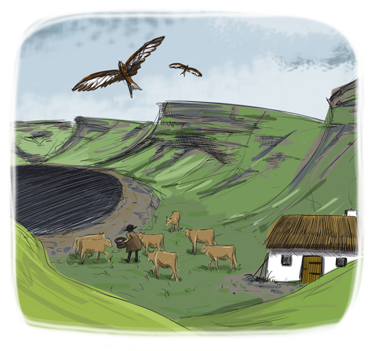Llyn y Fan Fach
Have you ever wondered how herbs and plants can heal people? Have you ever wondered what is lying beneath a lake?
In the late twelfth century, a widow lived at Blaensawdde, near Llanddeusant, Carmarthenshire. Her only son looked after the livestock near the small lake called LIyn-y-Fan Fach, in the shadow of the Black Mountain.

On a warm summer's day he loved nothing better than to sit beside the lake, daydreaming, as the cattle browsed the mountain grasses. He watched the Red Kites fly above his head, seemingly skimming the mountain's edge as they hunted.
One day whilst walking along the edge of the lake he saw a beautiful girl sitting on the surface of the lake. She was one of the most beautiful girls he had even seen. He immediately fell in love with this girl and wanted to marry her.

The farmer offered her three types of bread. On the first day he offered her hard bread but she refused it and dived back down to the bottom of the lake. On the second day he offered her dough but she also refused this. He decided to offer her lightly baked bread on the third day. She accepted this bread and also agreed to marry him.
She then disappeared back into the lake and returned with her father and identical sister. The father devised a plan to see whether the farmer really wanted to marry his daughter. He asked the farmer to find any differences between his two daughters. Although they looked exactly the same, the farmer recognized his beautiful girl from the way she tied her sandals.
The father decided to allow the farmer to marry his daughter on one condition. He was only allowed to strike his daughter three times, and on the third time she would disappear into the lake forever.
The farmer and the Lady married and they went to live at a farm called Esgair Llaethdy, about a mile from Myddfai. As a wedding gift they received more animals than they could count including cattle, sheep, goats and horses.

They were very happy farming at their farm Esgair Llaethdy and they had three beautiful sons.
However, the farmer forgot about the condition of his marriage and struck his wife three times! Unfortunately he struck his wife when she laughed during a funeral, once when she cried at a wedding and then he accidently touched her with the metal part of the bridle as she helped him to harness a horse.

Away his wife disappeared back into the lake along with all the fairy cattle/ wedding gifts. The only trace they left was the furrow made by the plough which the oxen drew after them into the lake and this can be seen there today!
However, the story does not end there. The farmer died of broken heart. The three sons spent most of their days wandering about the lake in the hope of seeing their mother once more.


One day she re-emerged near Dôl Howel, at the Mountain Gate, still called ‘Llidiart y Meddygon’, the Physicians’ gate, and told Rhiwallon, the eldest son, that he must become a man of medicine and be "a benefactor to mankind by giving relief from pain and misery through healing all manner of diseases’.
She told him that his purpose on earth was to heal the sick and ease their suffering. She took them to a place called the Physician’s Dingle (Pant y Meddygon), where she showed them the where the plants and herbs grew, and taught them the art of healing.
Rhiwallon and his sons Cadwgan, Gruffydd and Einion became the most skilful physicians in the land. Rhys Grug, Lord of Llandovery and Dynevor Castles, gave them rank, lands and privileges at Myddfai to practice their art of healing people. The fame of the Physicians of Myddfai was established' over the whole of Wales, and continued for centuries among their descendants. Meddygon Myddfai’s cures for illness such as coughs and chilblains (coarsely powdered mustard seed boiled with figs in strong ale) were published in The Red Book of Hergest.

Llyn y Fan Fach can be seen today in the Brecon Beacons National Park. The plough marks made by the oxen when the Lady of the Lake disappeared for the last time can be seen beside the lake.
When you read legends it is very difficult to believe everything. Why not try to find out how much of the legend is true? For example, can you find different accounts of whether Esgair Llaethdy was a farm or a small-holding? Are there any links between the Physicians of Myddfai and the National Botanic Garden of Wales? Bronze Age people often lived on or beside lakes and were noted for their healing powers and understanding of herbal remedies. Are there any links between the Celtic Bronze Age people and the origin of legend?
Key Questions
Question 2
Llyn y Fan Fach
Use the page corners to read the book.
1. In which country in the United Kingdom did the legend take place?
2. Where in Wales did the legend take place?
3. Why are national parks important? Who uses the Brecon Beacon National Park?
4. What do you think you will be able to see in a national park?
5. Are National Parks in danger? What might happen in the future to our National Parks?

